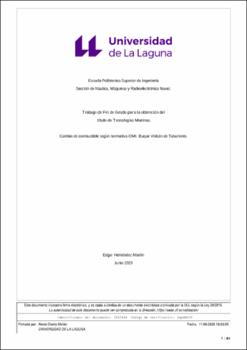Cambio de combustible según normativa OMI. Buque Volcán de Taburiente.
Autor
Hernández Martín, EdgarFecha
2020Resumen
El trabajo realizado trata de representar una nueva forma de adaptación a la normativa
implantada por la OMI para la reducción del contenido de azufre hasta 0,5% en los
combustibles de los buques valorando la importancia y el impacto que implica cumplir
dicha normativa.
En la primera parte se da paso a la comprensión acerca de los combustibles marinos y las
distintas formas de poder adaptarse al nuevo cambio de normativa implantada a partir del
1 de enero del 2020 por la OMI.
La segunda parte recoge de una manera más detallada el tipo de buque al que se le va a
realizar la adaptación a la nueva normativa, exponiendo los diferentes elementos
existentes en la sala de máquinas. Se presentarán los sistemas y elementos de
combustibles más importantes respecto a la adaptación al cambio de normativa.
Finalmente, el último capítulo recoge los resultados donde se presentará el proceso
llevado a cabo para la adaptación al nuevo cambio, estudiando los elementos más
afectados del sistema del combustible y observando las consecuencias obtenidas una vez
cumplida la adaptación a la nueva normativa. The degree project try to represent a new form of adaptation to the regulations introduced
by the IMO for the reduction of sulphur content to 0.5% in ship fuels, assessing the
importance and impact of complying with these regulations.
In the first part, we will understand marine fuels and the different ways to adapt to the
new regulations introduced by the IMO as of 1 January 2020.
The second part includes a more detailed description of the type of ship that will be
adapted to the new regulations, explaining the different elements that exist in the engine
room. The most important systems and fuel elements will be presented with regard to
adaptation to the change in regulations.
Finally, the last chapter includes the results where the process carried out for the
adaptation to the new change will be presented, studying the most affected elements of
the fuel system and observing the consequences obtained once the adaptation to the new
regulations is completed.





